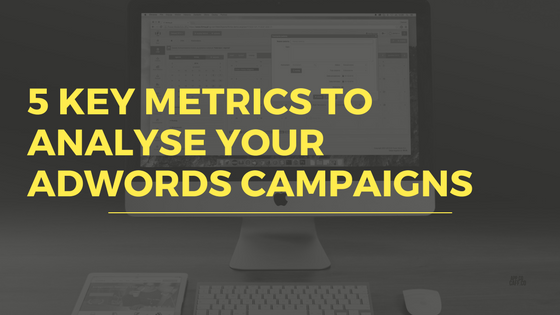
5 key metrics to analyse your Google Adwords campaigns
By Team EtchRock in Adwords & SEO,EtchRock
- 5 ways to boost your post-event engagement - June 22, 2017
- 7 ways to grow your email database - June 15, 2017
- 5 ways to increase slowing ticket sales - May 29, 2017
5 key metrics for analysing your Adwords Campaigns
When it comes to analysing your Google Adwords campaigns, there is no shortage of metrics that you can use to scope your success. But going through these daily can and will suck up most of your time. If you’re just looking for a quick overview of how your campaigns are operating, there are a few metrics that are KPI’s that you need to focus on.
If you’re completely new to Adwords and haven’t yet set up your first campaign, checkout out our blogs on getting started with Adwords, learning the basics of keywords or how to create your first ad.
If you don’t have the time to scrawl through pages of Excel data daily, here are five key metrics for you to monitor in your Adwords campaigns to keep you on top of everything.
Click through rate (CTR)
Click through rate is a ratio that is used to measure how many times your ad is being click compared to how many times it is viewed. Your CTR will help you to gauge how well your keywords and ads are performing.
It’s a simple formula that Google uses to get your CTR. Just divide the number of clicks by the number of impressions (clicks ÷ impressions = CTR). So for example, if your ad has had 10 clicks and 1,000 impressions, your CTR would be 0.1% (10 ÷ 1000 = 0.1).
A high click-through rate tells Google that your ad and keywords are relevant to your audience. If you’re not getting great results, try using a different combination of keywords and copy in your ad. Remember to make sure that your keywords in your ad are matching those in your ad groups!
Cost per click (CPC)
Your CPC is how much you are paying for someone to click on your ad. This is an important metric to monitor as it relates to where your money is being allocated. With keywords costs in constant fluctuation, you will need to check up regularly to make sure that you can adjust your campaigns accordingly.
One of the best ways to do this is by setting a maximum CPC for your various ad groups which you will have done in set up. If you have set a high maximum CPC for highly competitive keywords, you need to be aware that you may suddenly find yourself overspending on what you originally planned.
Conversion Rate
Conversion rate is a term that is not only limited to Google Adwords. It is a percentage used to find out the number of ‘conversions’ that take place on your site. We use the term ‘conversion’ for measuring the desired action that we want a visitor to take. Examples include:
-Buying a ticket
-Signing up for an account
-Download a whitepaper or other document
-Requesting more information
Where as the other metrics in this article focus on the effectiveness of your ads, conversion rate is all about the performance of your site or landing page. It’s telling us what is happening after a person has clicked on your ad.
You work out conversion rate by taking the number of ad clicks and dividing them by the number of conversions. For example, if you had 100 conversions from 1000 ad clicks, that would make your conversion rate 10% (100 conversions ÷ 1000 clicks = 10% conversion rate).
If you have a good conversion rate, this usually tells you that what you are doing is successful. People are clicking on your ads and then taking the action that you desire (whatever that may be). If you have a high CTR and a low conversion rate, this tells us that you need to either review the information on your landing page as it isn’t relevant to your audience. Or you need to rethink who you are targeting your ads towards.
Cost per conversion
Leading on from your conversion rate, your cost per conversion tells you how much each one of those individual conversions cost you. Knowing this metric is crucial for any Adwords campaign, as you obviously want to know if you’re making any money off your efforts.
If you’re selling a product, it’s a great metric that will tell you right away if you’re making any profit. For example, if your selling marathon tickets for £20 and paid £1 for someone to click on your ad, then they go ahead and buy one, you’ve made a tidy profit.
The marketer’s ultimate goal is to now lower that cost per conversion, which ultimately makes your campaigns more successful. This encompasses not only optimising your ads but your website/landing pages as well. To bring your cost per conversion down, you need to be thinking about your whole conversion funnel.
Quality Score
Quality score is a metric that is created by Google that estimates the overall quality of your ads. It takes into account your ad copy, keywords and landing page relevance to give your ad a score out of ten. It’s an indicator to see how Google views the effectiveness of your campaigns.
As you increase your quality score you will notice that good things happen to your account, your CPC will down and your average position of your ad will go up.
If you have just started your campaign, don’t worry too much about your quality score. It takes a while for all the results to collate and show. Be aware, that if you make any changes to a live campaign, this will drop your quality score.
Don’t forget to subscribe to be kept up to date with the latest event management news!
Team Etchrock


